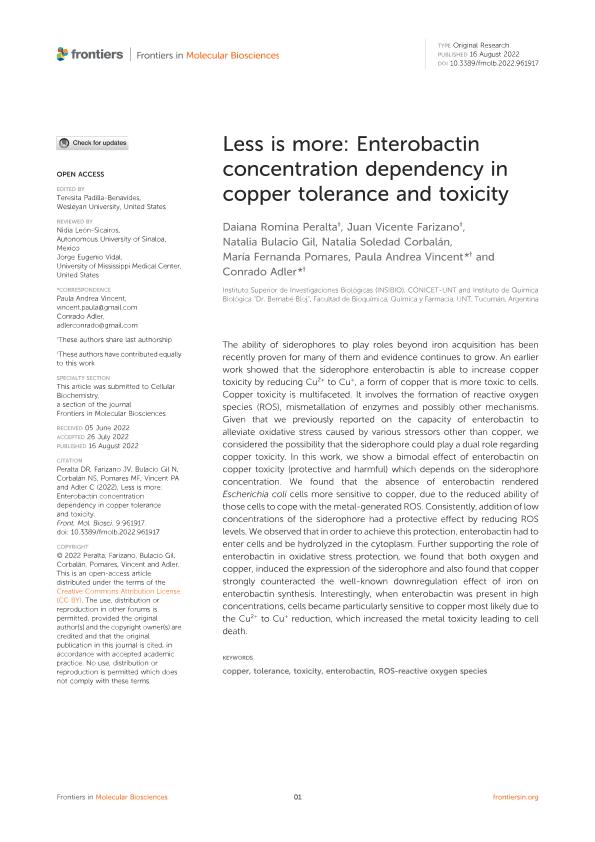Mostrar el registro sencillo del ítem
dc.contributor.author
Peralta, Daiana Romina

dc.contributor.author
Farizano, Juan Vicente

dc.contributor.author
Bulacio Gil, Natalia María

dc.contributor.author
Corbalan, Natalia Soledad

dc.contributor.author
Pomares, Maria Fernanda

dc.contributor.author
Vincent, Paula Andrea

dc.contributor.author
Adler, Conrado

dc.date.available
2023-07-27T14:18:14Z
dc.date.issued
2022-08
dc.identifier.citation
Peralta, Daiana Romina; Farizano, Juan Vicente; Bulacio Gil, Natalia María; Corbalan, Natalia Soledad; Pomares, Maria Fernanda; et al.; Less is more: Enterobactin concentration dependency in copper tolerance and toxicity; Frontiers Media; Frontiers in Molecular Biosciences; 9; 961917; 8-2022; 1-12
dc.identifier.uri
http://hdl.handle.net/11336/205818
dc.description.abstract
The ability of siderophores to play roles beyond iron acquisition has been recently proven for many of them and evidence continues to grow. An earlier work showed that the siderophore enterobactin is able to increase copper toxicity by reducing Cu2+ to Cu+, a form of copper that is more toxic to cells. Copper toxicity is multifaceted. It involves the formation of reactive oxygen species (ROS), mismetallation of enzymes and possibly other mechanisms. Given that we previously reported on the capacity of enterobactin to alleviate oxidative stress caused by various stressors other than copper, we considered the possibility that the siderophore could play a dual role regarding copper toxicity. In this work, we show a bimodal effect of enterobactin on copper toxicity (protective and harmful) which depends on the siderophore concentration. We found that the absence of enterobactin rendered Escherichia coli cells more sensitive to copper, due to the reduced ability of those cells to cope with the metal-generated ROS. Consistently, addition of low concentrations of the siderophore had a protective effect by reducing ROS levels. We observed that in order to achieve this protection, enterobactin had to enter cells and be hydrolyzed in the cytoplasm. Further supporting the role of enterobactin in oxidative stress protection, we found that both oxygen and copper, induced the expression of the siderophore and also found that copper strongly counteracted the well-known downregulation effect of iron on enterobactin synthesis. Interestingly, when enterobactin was present in high concentrations, cells became particularly sensitive to copper most likely due to the Cu2+ to Cu+ reduction, which increased the metal toxicity leading to cell death.
dc.format
application/pdf
dc.language.iso
eng
dc.publisher
Frontiers Media

dc.rights
info:eu-repo/semantics/openAccess
dc.rights.uri
https://creativecommons.org/licenses/by/2.5/ar/
dc.subject
COOPER
dc.subject
TOLERANCE
dc.subject
TOXICITY
dc.subject
ENTEROBACTIN
dc.subject
ROS-REACTIVE OXYGEN SPECIES
dc.subject.classification
Bioquímica y Biología Molecular

dc.subject.classification
Ciencias Biológicas

dc.subject.classification
CIENCIAS NATURALES Y EXACTAS

dc.title
Less is more: Enterobactin concentration dependency in copper tolerance and toxicity
dc.type
info:eu-repo/semantics/article
dc.type
info:ar-repo/semantics/artículo
dc.type
info:eu-repo/semantics/publishedVersion
dc.date.updated
2023-07-10T10:31:09Z
dc.identifier.eissn
2296-889X
dc.journal.volume
9
dc.journal.number
961917
dc.journal.pagination
1-12
dc.journal.pais
Suiza

dc.journal.ciudad
Lausana
dc.description.fil
Fil: Peralta, Daiana Romina. Consejo Nacional de Investigaciones Científicas y Técnicas. Centro Científico Tecnológico Conicet - Tucumán. Instituto Superior de Investigaciones Biológicas. Universidad Nacional de Tucumán. Instituto Superior de Investigaciones Biológicas; Argentina. Universidad Nacional de Tucumán. Facultad de Bioquímica, Química y Farmacia. Instituto de Química Biológica; Argentina
dc.description.fil
Fil: Farizano, Juan Vicente. Consejo Nacional de Investigaciones Científicas y Técnicas. Centro Científico Tecnológico Conicet - Tucumán. Instituto Superior de Investigaciones Biológicas. Universidad Nacional de Tucumán. Instituto Superior de Investigaciones Biológicas; Argentina. Universidad Nacional de Tucumán. Facultad de Bioquímica, Química y Farmacia. Instituto de Química Biológica; Argentina
dc.description.fil
Fil: Bulacio Gil, Natalia María. Consejo Nacional de Investigaciones Científicas y Técnicas. Centro Científico Tecnológico Conicet - Tucumán. Instituto Superior de Investigaciones Biológicas. Universidad Nacional de Tucumán. Instituto Superior de Investigaciones Biológicas; Argentina. Universidad Nacional de Tucumán. Facultad de Bioquímica, Química y Farmacia. Instituto de Química Biológica; Argentina
dc.description.fil
Fil: Corbalan, Natalia Soledad. Universidad Nacional de Salta. Facultad de Cs.naturales. Escuela de Biología; Argentina. Consejo Nacional de Investigaciones Científicas y Técnicas. Centro Científico Tecnológico Conicet - Tucumán. Instituto Superior de Investigaciones Biológicas. Universidad Nacional de Tucumán. Instituto Superior de Investigaciones Biológicas; Argentina. Universidad Nacional de Tucumán. Facultad de Bioquímica, Química y Farmacia. Instituto de Química Biológica; Argentina
dc.description.fil
Fil: Pomares, Maria Fernanda. Consejo Nacional de Investigaciones Científicas y Técnicas. Centro Científico Tecnológico Conicet - Tucumán. Instituto Superior de Investigaciones Biológicas. Universidad Nacional de Tucumán. Instituto Superior de Investigaciones Biológicas; Argentina. Universidad Nacional de Tucumán. Facultad de Bioquímica, Química y Farmacia. Instituto de Química Biológica; Argentina
dc.description.fil
Fil: Vincent, Paula Andrea. Consejo Nacional de Investigaciones Científicas y Técnicas. Centro Científico Tecnológico Conicet - Tucumán. Instituto Superior de Investigaciones Biológicas. Universidad Nacional de Tucumán. Instituto Superior de Investigaciones Biológicas; Argentina. Universidad Nacional de Tucumán. Facultad de Bioquímica, Química y Farmacia. Instituto de Química Biológica; Argentina
dc.description.fil
Fil: Adler, Conrado. Consejo Nacional de Investigaciones Científicas y Técnicas. Centro Científico Tecnológico Conicet - Tucumán. Instituto Superior de Investigaciones Biológicas. Universidad Nacional de Tucumán. Instituto Superior de Investigaciones Biológicas; Argentina. Universidad Nacional de Tucumán. Facultad de Bioquímica, Química y Farmacia. Instituto de Química Biológica; Argentina
dc.journal.title
Frontiers in Molecular Biosciences
dc.relation.alternativeid
info:eu-repo/semantics/altIdentifier/url/https://www.frontiersin.org/articles/10.3389/fmolb.2022.961917/full
dc.relation.alternativeid
info:eu-repo/semantics/altIdentifier/doi/http://dx.doi.org/10.3389/fmolb.2022.961917
Archivos asociados
